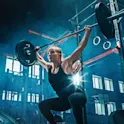Sex disparities in sports medicine research may threaten the health and careers of female athletes
By Emily Parker, University of Iowa Carver College of Medicine Image: leungchopan/Shutterstock.com ‘Hormones’ have long been blamed for anterior cruciate ligament (ACL) injuries in female athletes, but according to a new review paper, one menstrual hormone may be mediating the damage: relaxin. University of Iowa Carver College of Medicine student, Emily Parker, writes to Frontiers that upon noticing the lack of progress in the 20-odd years since early relaxin-musculoskeletal studies, the support of orthopedic department mentors and the assistance of a fellow student allowed a thorough dive into the disjointed, cross-disciplinary research trail. Female athletes are between three and eight times more likely to suffer devastating ACL injuries compared to their male counterparts. That’s according to 16 years of data from the US National Collegiate Athletics Association (NCAA) Injury Surveillance System, published in a new paper to Frontiers in Endocrinology. Alex Meyer, one of the authors of this latest research, noted: “It has almost been accepted that these [ACL injuries] are just more prevalent in women.” The cost of female ACL injuries is huge and multi-faceted, seen in the billions of dollars of healthcare costs, team rosters picked apart by injury come tournament time, and future consequences such as post-traumatic […]














